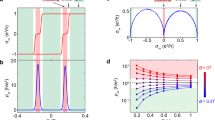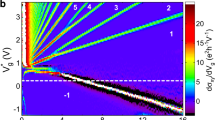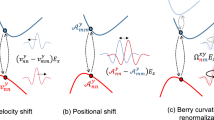Abstract
A quantum anomalous Hall (QAH) insulator is characterized by quantized Hall and vanishing longitudinal resistances at zero magnetic field that are protected against local perturbations and independent of sample details. This insensitivity makes the microscopic details of the local current distribution inaccessible to global transport measurements. Accordingly, the current distributions that give rise to transport quantization are unknown. Here we use magnetic imaging to directly visualize the transport current in the QAH regime. As we tune through the QAH plateau by electrostatic gating, we clearly identify a regime in which the sample transports current primarily in the bulk rather than along the edges. Furthermore, we image the local response of equilibrium magnetization to electrostatic gating. Combined, these measurements suggest that the current flows through incompressible regions whose spatial structure can change throughout the QAH regime. Identification of the appropriate microscopic picture of electronic transport in QAH insulators and other topologically non-trivial states of matter is a crucial step towards realizing their potential in next-generation quantum devices.
This is a preview of subscription content, access via your institution
Access options
Access Nature and 54 other Nature Portfolio journals
Get Nature+, our best-value online-access subscription
$29.99 / 30 days
cancel any time
Subscribe to this journal
Receive 12 print issues and online access
$259.00 per year
only $21.58 per issue
Buy this article
- Purchase on Springer Link
- Instant access to full article PDF
Prices may be subject to local taxes which are calculated during checkout




Similar content being viewed by others
Data availability
The data supporting the plots and findings of this paper are available at Zenodo: https://doi.org/10.5281/zenodo.8037337
References
Büttiker, M. Absence of backscattering in the quantum Hall effect in multiprobe conductors. Phys. Rev. B 38, 9375–9389 (1988).
Thouless, D. Edge voltages and distributed currents in the quantum Hall effect. Phys. Rev. Lett. 71, 1879–1882 (1993).
Lai, K. et al. Imaging of coulomb-driven quantum Hall edge states. Phys. Rev. Lett. 107, 176809 (2011).
Cui, Y.-T. et al. Unconventional correlation between quantum Hall transport quantization and bulk state filling in gated graphene devices. Phys. Rev. Lett. 117, 186601 (2016).
Weis, J. & Von Klitzing, K. Metrology and microscopic picture of the integer quantum Hall effect. Philos. Trans. A Math. Phys. Eng. Sci. 369, 3954–3974 (2011).
Marguerite, A. et al. Imaging work and dissipation in the quantum Hall state in graphene. Nature 575, 628–633 (2019).
Haldane, F. D. M. Model for a quantum Hall effect without Landau levels: condensed-matter realization of the ‘parity anomaly’. Phys. Rev. Lett. 61, 2015–2018 (1988).
Yu, R. et al. Quantized anomalous Hall effect in magnetic topological insulators. Science 329, 61–64 (2010).
Chang, C.-Z. et al. Experimental observation of the quantum anomalous Hall effect in a magnetic topological insulator. Science 340, 167–170 (2013).
Lachman, E. O. et al. Visualization of superparamagnetic dynamics in magnetic topological insulators. Sci. Adv. 1, e1500740 (2015).
Lachman, E. O. et al. Observation of superparamagnetism in coexistence with quantum anomalous Hall C = ±1 and C = 0 Chern states. NPJ Quantum Mater. 2, 70 (2017).
Wang, W. et al. Direct evidence of ferromagnetism in a quantum anomalous Hall system. Nat. Phys. 14, 791–795 (2018).
Tschirhart, C. et al. Imaging orbital ferromagnetism in a moiré Chern insulator. Science 372, 1323–1327 (2021).
Allen, M. et al. Visualization of an axion insulating state at the transition between 2 chiral quantum anomalous Hall states. Proc. Natl Acad. Sci. USA 116, 14511–14515 (2019).
Huber, M. E. et al. Gradiometric micro-SQUID susceptometer for scanning measurements of mesoscopic samples. Rev. Sci. Instrum. 79, 053704 (2008).
Caviglia, A. et al. Electric field control of the LaAlO3/SrTiO3 interface ground state. Nature 456, 624–627 (2008).
Bell, C. et al. Dominant mobility modulation by the electric field effect at the LaAlO3/SrTiO3 interface. Phys. Rev. Lett. 103, 226802 (2009).
Biscaras, J. et al. Limit of the electrostatic doping in two-dimensional electron gases of LaXO3 (X = Al, Ti)/SrTiO3. Sci. Rep. 4, 6788 (2014).
Mikheev, E., Rosen, I. T. & Goldhaber-Gordon, D. Quantized critical supercurrent in SrTiO3-based quantum point contacts. Sci. Adv. 7, eabi6520 (2021).
Yin, C. et al. Electron trapping mechanism in LaAlO3/SrTiO3 heterostructures. Phys. Rev. Lett. 124, 017702 (2020).
Kandala, A., Richardella, A., Kempinger, S., Liu, C.-X. & Samarth, N. Giant anisotropic magnetoresistance in a quantum anomalous Hall insulator. Nat. Commun. 6, 7434 (2015).
Xiao, D., Chang, M.-C. & Niu, Q. Berry phase effects on electronic properties. Rev. Mod. Phys. 82, 1959–2007 (2010).
Streda, P. & Smrcka, L. Thermodynamic derivation of the Hall current and the thermopower in quantising magnetic field. J. Phys. C Solid State Phys. 16, L895–L899 (1983).
Widom, A. Thermodynamic derivation of the Hall effect current. Phys. Lett. A 90, 474–474 (1982).
Kohmoto, M., Halperin, B. I. & Wu, Y.-S. Diophantine equation for the three-dimensional quantum Hall effect. Phys. Rev. B 45, 13488–13493 (1992).
Tcakaev, A. et al. Comparing magnetic ground-state properties of the v-and cr-doped topological insulator (Bi, Sb)2Te3. Phys. Rev. B 101, 045127 (2020).
Checkelsky, J. G., Ye, J., Onose, Y., Iwasa, Y. & Tokura, Y. Dirac-fermion-mediated ferromagnetism in a topological insulator. Nat. Phys. 8, 729–733 (2012).
Chklovskii, D., Shklovskii, B. I. & Glazman, L. Electrostatics of edge channels. Phys. Rev. B 46, 4026–4034 (1992).
Van Son, P. & Klapwijk, T. Current contacts and current distribution in the quantum Hall effect. Europhys. Lett. 12, 429–434 (1990).
Hirai, H. & Komiyama, S. Ratio between edge and bulk currents in the quantum Hall effect. Phys. Rev. B 49, 14012–14015 (1994).
Roukes, M. L., Freeman, M., Germain, R., Richardson, R. & Ketchen, M. Hot electrons and energy transport in metals at millikelvin temperatures. Phys. Rev. Lett. 55, 422–425 (1985).
Wellstood, F., Urbina, C. & Clarke, J. Hot-electron effects in metals. Phys. Rev. B 49, 5942–5955 (1994).
Liu, M. et al. Large discrete jumps observed in the transition between chern states in a ferromagnetic topological insulator. Sci. Adv. 2, e1600167 (2016).
Rodenbach, L. K. et al. Bulk dissipation in the quantum anomalous Hall effect. APL Mater. 9, 081116 (2021).
Klass, U., Dietsche, W., Von Klitzing, K. & Ploog, K. Fountain-pressure imaging of the dissipation in quantum-Hall experiments. Phys. Rev. B Condens. Matter 169, 363–367 (1991).
Klass, U., Dietsche, W., von Klitzing, K. & Ploog, K. Image of the dissipation in gated quantum Hall effect samples. Surf. Sci. 263, 97–99 (1992).
Kalisky, B. et al. Locally enhanced conductivity due to the tetragonal domain structure in LaAlO33/SrTiO3 heterointerfaces. Nat. Mater. 12, 1091–1095 (2013).
Ma, E. Y. et al. Mobile metallic domain walls in an all-in-all-out magnetic insulator. Science 350, 538–541 (2015).
Bachmann, M. D. et al. Spatial control of heavy-fermion superconductivity in ceirin5. Science 366, 221–226 (2019).
Yang, F. et al. Nematic transitions in iron pnictide superconductors imaged with a quantum gas. Nat. Phys. 16, 514–519 (2020).
Kalisky, B. et al. Stripes of increased diamagnetic susceptibility in underdoped superconducting Ba(Fe1−xCOx)2As2 single crystals: evidence for an enhanced superfluid density at twin boundaries. Phys. Rev. B 81, 184513 (2010).
Aharon-Steinberg, A. et al. Long-range nontopological edge currents in charge-neutral graphene. Nature 593, 528–534 (2021).
McCormick, K. L. et al. Scanned potential microscopy of edge and bulk currents in the quantum Hall regime. Phys. Rev. B 59, 4654–4657 (1999).
Rosen, I. T. et al. Measured potential profile in a quantum anomalous Hall system suggests bulk-dominated current flow. Phys. Rev. Lett. 129, 246602 (2022).
Lian, B., Sun, X.-Q., Vaezi, A., Qi, X.-L. & Zhang, S.-C. Topological quantum computation based on chiral majorana fermions. Proc. Natl Acad. Sci. USA 115, 10938–10942 (2018).
Okazaki, Y. et al. Quantum anomalous Hall effect with a permanent magnet defines a quantum resistance standard. Nat. Phys. 18, 25–29 (2022).
Sample, H., Bruno, W., Sample, S. & Sichel, E. Reverse-field reciprocity for conducting specimens in magnetic fields. J. Appl. Phys. 61, 1079–1084 (1987).
Acknowledgements
We thank C.-Z. Chang and P. L. McEuen for valuable discussions and C. Clement and J. P. Sethna for help with the reconstruction methods. Work at Cornell University was primarily supported by the US Department of Energy, Office of Basic Energy Sciences, Division of Materials Sciences and Engineering, under award no. DE-SC0015947. Sample synthesis and fabrication at Penn State was supported by the Penn State 2DCC-MIP under NSF Grant nos. DMR-1539916 and DMR-2039351.
Author information
Authors and Affiliations
Contributions
K.C.N. conceived the experiment. K.C.N. and N.S. supervised the research. G.M.F. performed scanning SQUID microscopy, electrical transport measurements and data analysis. R.X. grew and characterized the magnetically doped topological insulator films and fabricated the devices with help from A.R.R. G.M.F. and K.C.N. wrote the manuscript with contributions from all authors.
Corresponding author
Ethics declarations
Competing interests
The authors declare no competing interests.
Peer review
Peer review information
Nature Materials thanks the anonymous reviewers for their contribution to the peer review of this work.
Additional information
Publisher’s note Springer Nature remains neutral with regard to jurisdictional claims in published maps and institutional affiliations.
Extended data
Extended Data Fig. 1 Transport measurement configurations.
Schematics showing the configurations to measure (a) Ryx, (c) R2T and (b,d) the combinations needed to obtain Rxx interchanging current and voltage probes. (e) Hall resistance (Ryx, blue) as shown in Fig. 1d and longitudinal resistance (Rxx, red) measured as described in (b,d).
Extended Data Fig. 2 Current imaging on the two-terminal sample.
Imaging the current density on a two-terminal sample fabricated from the same thin film. (a) R2T co-recorded with magnetic imaging versus VBG. 300 Ω of wire resistance is subtracted. Color-coded points correspond to the colored traces. (b) SQUID flux, ΦI, with Ia.c. = 25 nA and IDC = 0. The film is magnetized out of the plane. (c) Reconstructed current density from (b). (e) Reconstructed current density for VBG range in which the two-terminal resistance is near quantization. (f-i) Same as (a-e) with a different sample configuration. The film is magnetized into the plane. We source Ia.c. = 25 nA with a positive \({I}_{DC}={I}_{a.c.}^{p}=35.3\,{{{\rm{nA}}}}\).
Extended Data Fig. 3 Current reconstruction at different bias levels.
Reconstructed current density normalized by Ia.c. for different bias levels. The Hall bar is biased with a positive DC offset such that \({I}_{a.c.}^{\,p}={I}_{d.c.}\). Traces are color-coded and offset vertically by the back-gate voltage for comparison. (a) Ia.c. = 10 nA. (b) Ia.c. = 15 nA, reproduced from figure 2. (c) Ia.c. = 20 nA. (d) Ia.c. = 30 nA. (e-h) same as (a-d) with, zoomed in on the VBG corresponding to the QAH regime.
Extended Data Fig. 4 Comparing data acquired at low bias currents.
Same data as in Extended Data Fig. 3 but focusing on only low bias currents. Traces are color-coded and offset for clarity to indicate the back gate voltage. (a) Ia.c. = 10 nA. (b) Ia.c. = 15 nA. The VBG corresponding to the center of the QAH regime is shifted by approximately 15 V between the two data sets (see Supplementary Section 2 for details).
Extended Data Fig. 5 Current bias dependence of the Hall resistance.
Dependence of the Hall resistance on Ia.c. current bias. Overlaid contours indicate the deviation from the quanitzed value as VBG and bias current are adjusted.
Extended Data Fig. 6 Registration of different gate sweeps.
(a) dM/dVTG data with co-recorded measurements of Ryx versus VBG. Blue points mark the minimum in dM/dVTG for each position y along the channel. Blue curve is a 5th order polynomial fit to the points. (b) Same as (a) with for the dM/dVTG data presented in Fig. 3 and 4a for which Ryx was not co-recorded. (c) Comparison of the polynomial fits in (a) and (b). Based on the alignment of the polynomial fits, we use the same V0 for both dM/dV datasets. (d) Comparison of Ryx co-recorded with (a) and the current imaging data in Fig. 2b. Ryx measured with Ia.c. = 15 nA and co-recorded with magnetic imaging data (green) compared to Ryx measured with Ia.c. = 2.5 nA measured at each back gate voltage in the dM/dV data in figure (a) (blue). Vertical lines denote the gate voltages VOff where Ryx is maximized. A difference of 11.2 V is observed between the two data sets. The two values VOff are used for comparing data in Fig. 4a,b.
Extended Data Fig. 7 Hot-spots and bias-induced heating.
(a) Flux signal produced with Ia.c. = 20 nA from contacts 1 to 2 (as indicated in (d)) with the sample gated into the quantized regime and the sample magnetized out of the plane. A strong signal is observed at the corners of the contacts. (b) Same as (a) with the static magnetization reversed. The location of the hot-spots changes and the sign of the signal is inverted. This is consistent with local demagnetization at the sample corners when the sample is gated into the quantum anomalous Hall regime. (c) Same as (a) with the sample gated away from the quantized regime. Signs of demagnetization are observed throughout the sample. (d) Same as (c) with the magnetization reversed. (e-f) Flux linecuts over the two terminal device gated far away from the quantum anomalous Hall regime with Ia.c. = 25 nA bias current and \({I}_{d.c.}={I}_{a.c.}^{\,p}\) with the sample magnetized out of the plane (e), and with the sample magnetized into the plane (f). The signals change sign with the magnetization direction and have a weak dependence on DC bias direction, indicating that they arise from a partial demagnetization of the sample rather than the transport current density.
Extended Data Fig. 8 Extended back gate voltage range for data shown in Fig. 2d and Fig. 4b.
(a) Integral of the reconstructed current density, jx over width of the Hall bar along y. Colors indicate line trace where the Hall resistance is closest to the quantized value. Red line indicated 15 nA, which is the bias current. Outside the quantized regime, we find deviations between the total reconstructed current and the applied current due to heating-induced signals as discussed in the main text. (b) Ryx and (c) R2T versus VBG co-recorded with the imaging. (d) SQUID flux detected over the channel as a function of back gate voltage. Color-coded traces correspond to data displayed in Fig 2. Traces in black are dominated by a partial demagnetization of the due to bias-induced heating. (e) Reconstructed current density for the traces in (e). (f) Color-coded traces from (e) re-plotted on a new y-scale.
Extended Data Fig. 9 SQUID point spread function.
Image of the SQUID point spread function, KPSF extracted from imaging a superconducting vortex. The SQUID pickup loop has an inner diameter of 1.5 μm, giving few-micrometer scale spatial resolution for magnetic imaging.
Supplementary information
Supplementary Information
Supplementary Figs. 1–20, Sections 1–6 and Refs. 48–53.
Rights and permissions
Springer Nature or its licensor (e.g. a society or other partner) holds exclusive rights to this article under a publishing agreement with the author(s) or other rightsholder(s); author self-archiving of the accepted manuscript version of this article is solely governed by the terms of such publishing agreement and applicable law.
About this article
Cite this article
Ferguson, G.M., Xiao, R., Richardella, A.R. et al. Direct visualization of electronic transport in a quantum anomalous Hall insulator. Nat. Mater. 22, 1100–1105 (2023). https://doi.org/10.1038/s41563-023-01622-0
Received:
Accepted:
Published:
Issue Date:
DOI: https://doi.org/10.1038/s41563-023-01622-0
This article is cited by
-
All-electric writing of a chiral quantum memory
Nature Materials (2024)
-
Characterization of Two Fast-Turnaround Dry Dilution Refrigerators for Scanning Probe Microscopy
Journal of Low Temperature Physics (2024)



